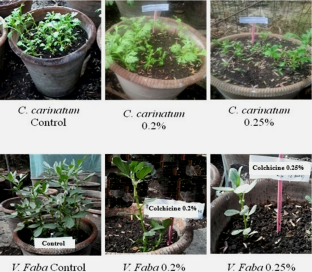The effect of Colchicine on Vicia faba and Chrysanthemum carinatum (L.) plants and their cytogenetical study
Kushwah Kalyan Singh, Patel Sapan, Chaurasiya Uma, Wani Mohd Bilal
Research Articles | Published: 22 March, 2021
First Page: 432
Last Page: 438
Views: 3821
Keywords: Chromosomes aberration, Chemical doubling agent, Growth parameters, Meiosis, Pollen‐fertility, Polyploidy
Abstract
We have prepared various colchicine concentrations and applied them on seedling of Chrysanthemum carinatum (2n = 18) and seeds of Vicia faba (2n = 12). Colchicine-induced polyploidy was reported in Chrysanthemum carinatum (2n = 4x = 36) and Vicia faba (2n = 4x = 24) plants. This research explains the polyploidy in respective plants which successfully results in apparent morphological and cytological changes in polyploid plants compared to the control plants. Phenotypic characters exhibited that polyploid plants initially had slightly slower growth, stronger stems, thicker and larger leaves, larger flowers, and seeds and then increases abruptly. There was an increment in cytological characters such as cell size, chiasma frequency in polyploid plants as compared to the control plants. Growth patterns, morphology, pollen staining, and seed sets were recorded in this work. However, the main emphasis was laid on the behavior of chromosomes of isolated polyploids.

References
- Bamakhramah HS, Halloran GM, Wilson JH (1984) Components of yield in diploid, tetraploid and hexaploid wheats (Triticum spp.). Ann Bot 51–60
- Cai D, Chen J, Chen D, Dai B, Zhang W, Song Z, Zhang D (2007) The breeding of two polyploid rice lines with the characteristic of polyploid meiosis stability. Sci China Ser C Life Sci 50(3):356–366
- Chakraborti SP, Vijayan K, Roy BN, Qadri SMH (1998) In vitro induction of tetraploidy in mulberry (Morus alba L.). Plant Cell Rep 17(10):799–803
- Cohen H, Fait A, Tel-Zur N (2013) Morphological, cytological and metabolic consequences of autopolyploidization in Hylocereus (Cactaceae) species. BMC Plant Biol 13(1):173
- Dar TH, Raina SN, Goel S (2017) Cytogenetic and molecular evidences revealing genomic changes after autopolyploidization: a case study of synthetic autotetraploid Phlox drummondii hook. Physiol Mol Biol Plants 23:641–650
- Denaeghe HER, Van Laere K, Leus L, Lootens P, Van Huylenbroeck J, Van Labeke MC (2018) The variable effect of polyploidization on the phenotype in Escallonia. Front Plant Sci 9:354
- del Pozo JC, Ramirez-Parra E (2014) Deciphering the molecular bases for drought tolerance in Arabidopsis autotetraploids. Plant Cell Environ 37(12):2722–2737
- Joshi P, Verma RC (2004) High frequency production of colchicine induced autotetraploids in faba bean (Vicia faba L.). Cytologia 69(2):141–147
- Kehr AE (1996) Woody plant polyploidy. Am Nurseryman 183:38–47
- Kermani MJ, Sarasan V, Roberts AV, Yokoya K, Wentworth J, Sieber VK (2003) Oryzalin-induced chromosome doubling in Rosa and its effect on plant morphology and pollen viability. Theor Appl Genet 107(7):1195–1200
- Kushwah KS, Verma RC, Patel S, Jain NK (2018) Colchicine induced polyploidy in Chrysanthemum carinatum L. J Phylogenet Evol Biol 6(193):2
- Kushwah KS, Patel S (2019) Effect of titanium dioxide nanoparticles (TiO2 NPs) on Faba bean (Vicia faba L.) and induced asynaptic mutation: a meiotic study. J Plant Growth Regul 1–12
- Li X, Yu E, Fan C, Zhang C, Fu T, Zhou Y (2012) Developmental, cytological and transcriptional analysis of autotetraploid Arabidopsis. Planta 236(2):579–596
- Lopes JML, Carvalho HH, Zorzatto C, Azevedo A, Machado MA, Salimena FRG et al (2019) Genetic relationships and polyploid origins in the Lippia alba complex. Am J Bot 107:1–11
- Manzoor A, Ahmad T, Bashir MA, Hafiz IA, Silvestri C (2019) Studies on colchicine induced chromosome doubling for enhancement of quality traits in ornamental plants. Plants 8(7):194
- Renny-Byfield S, Wendel JF (2014) Doubling down on genomes: polyploidy and crop plants. Am J Bot 101(10):1711–1725
- Sattler MC, Carvalho CR, Clarindo WR (2016) The polyploidy and its key role in plant breeding. Planta 243(2):281–296
- Schranz ME, Osborn TC (2000) Novel flowering time variation in the resynthesized polyploid Brassica napus. J Hered 91(3):242–246
- Shao J, Chen C, Deng X (2003) In vitro induction of tetraploid in pomegranate (Punica granatum). Plant Cell Tissue Organ Cult 75(3):241–246
- Väinölä A (2000) Polyploidization and early screening of Rhododendron hybrids. Euphytica 112(3):239–244
- Vergara F, Kikuchi J, Breuer C (2016) Artificial autopolyploidization modifies the tricarboxylic acid cycle and GABA shunt in Arabidopsis thaliana Col-0. Sci Rep 6:26515
- Verma DK, Patel S, Kushwah KS (2020) Synthesis of titanium dioxide (TiO2) nanoparticles and impact on morphological changes, seeds yield and phytotoxicity of Phaseolus vulgaris L. Trop Plant Res 7(1):158–170
- Verma RC, Ahirwar R, Das P (2011) Induction of polyploidy in Phlox drummondii. J Cytol Genet 12:1–6
- Wendel FM, Lütke Eversloh C, Machek EJ, Duirk SE, Plewa MJ, Richardson SD, Ternes TA (2014) Transformation of iopamidol during chlorination. Environ Sci Technol 48(21):12689–12697
- Wei KH, Xu JP, Li LX, Cai JY, Miao JH, Li MH (2018) In vitro induction and generation of tetraploid plants of Sophora tonkinensis Gapnep. Pharmacogn Mag 14:149–154
- Zelkowski M, Olson MA, Wang M, Pawlowski WP (2019) Diversity and determinants of meiotic recombination landscapes. Trends Genet
- Zhang H, An S, Hu J, Lin Z, Liu X, Bao H, Chen R (2018) Induction, identification and characterization of polyploidy in Stevia rebaudiana Bertoni. Plant Biotechnol 35(1):81–86
Author Information
School of Studies in Botany, Jiwaji University, Gwalior, India